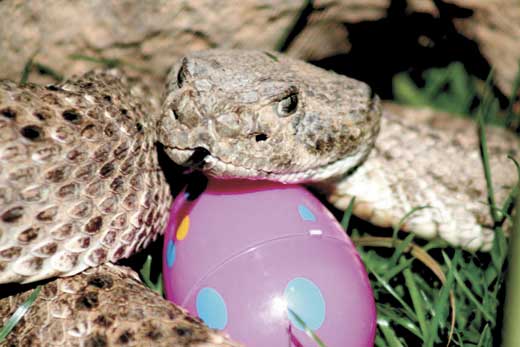
APRIL 16, 2014
Don't hide Easter eggs where rattlesnakes may curl up

SCOTTSDALE – If you're having an Easter egg hunt this weekend, be aware that rattlesnakes may like the same hiding spots you are planning to stash those eggs.
 With the warm weather, snakes have been very active lately. The Phoenix Herpetological Society (PHS) reports calls to remove snakes are up 25 percent this year compared with last year.
With the warm weather, snakes have been very active lately. The Phoenix Herpetological Society (PHS) reports calls to remove snakes are up 25 percent this year compared with last year.
PHS is offering some safety tips to avoid incidents with snakes that could spoil your Easter Egg hunt:
• Don't hide eggs on the ground where children will have to reach where they can’t see. That includes under bushes and rocks, behind flower pots, or under pool toys.
• Snakes especially like to curl up in shady damp areas, such as under plants with drip systems, during the day, so those areas should be off limits.
• Instead, hide eggs off the ground, such as in tall flower pots or hanging baskets, and on decks or outdoor furniture
• If you do find a snake, walk away and don't try to move it yourself. An estimated 80 to 90 percent of rattlesnake bites happen when homeowners try to deal with the snake themselves.
What to do if bitten by a rattlesnake:
• Call 911 and stay calm.
• Keep the bitten area still. You can immobilize the area with an improvised splint made from a board, magazines, or other stiff material tied to the limb (but don't tie it too tight because you don't want to reduce blood flow). Remove any jewelry or constricting items near the affected area in case of swelling.
• Elevate the extremity that’s bitten.
DO NOT:
• Drive yourself to the hospital.
• Use ice to cool the bite.
• Cut open the wound and try to suck out the venom.
• Use a tourniquet. This will cut off blood flow and the limb may be lost.
At least 13 species of rattlesnakes and a few other types of venomous snakes make their home in Arizona. However, far more non-venomous snakes are found in the state.
Phoenix Herpetological Society also wants people to understand that killing a snake or other reptile isn’t the best way of dealing with these creatures. “Wildlife plays an important role in our world,” says Russ Johnson, President of Phoenix Herpetological Society. “We can co-exist if we understand them better.”
For a fee, the Phoenix Herpetological Society will humanely remove a snake from your property.
For more information about Phoenix Herpetological Society, a nonprofit 501(c)(3) organization dedicated to the rehabilitation of rescued reptiles and educating the public about living with these amazing creatures, call 602-513-HERP (4377) or go to www.phoenixherp.com.
APRIL 16, 2014
Alternatives to debarking surgery
Debarking surgery is quite the controversy in pet news today. Is it inhumane? Do the possible risks outweigh the perceived benefits? These are viable questions to ask when considering debarking surgery to control your dog’s chronic barking. However, with April being the Prevention of Cruelty to Animals Month, it is also important to recognize the numerous available non-surgical alternatives that are said to be safer and even more effective by veterinarians and trainers alike.
As decipherable from the name, debarking surgery is the act of surgically disabling your dog from producing a loud, barking sound. “Although the procedure is called ‘debarking’, it does not result in the inability for the dog to produce any sound at all,” said Dr. Kelley Thieman, a clinical associate professor at the Texas A&M College of Veterinary Medicine & Biomedical Sciences. “Instead, the dog has a muffled quality to its bark, and in time could even regain the ability to bark.”
While the benefit of debarking surgery is the muffled-sounding bark, there are still numerous complications that could arise and definitely should not be overlooked. “Debarking surgery carries various risks,” said Thieman. “During the debarking procedure itself, risks could include bleeding, swelling (preventing air flow), infection, and anesthetic complications.” Scarring of the larynx can also occur after the surgery, and in some cases may be severe enough to restrict airflow. This would require yet another surgical procedure to remove the scar tissue so the dog could breathe, bringing with it more unnecessary risk.
Though tiresome when heard for hours on end, barking is an important way for our dogs to communicate with us. Excessive barking can often be Fido alerting us that there is a stranger nearby or even that he is in pain. Surgically disabling him from barking, though it might provide you with some relief, may not be appropriate when barking can also be controlled with a similarly effective alternative.
The best way to prevent unwanted barking, as advised by both veterinarians and professional dog trainers, is proper training. Some other alternatives could include adequate exercise and environmental enrichment. “No-bark collars, which discharge citronella spray or even a static shock in response to barking, are also available,” said Thieman. “However, I think that obedience training combined with exercise and fun dog activities are great options for controlling excessive barking.”
Most veterinarians agree that debarking surgery should be used only as a last result when all other options have failed, and even then some veterinary clinics refuse to perform the surgery. When considering your options, it is important to extensively consider the alternatives to help decide if the risks of putting your dog through unnecessary surgery are really worth the benefit.
Pet Talk is a service of the College of Veterinary Medicine & Biomedical Sciences, Texas A&M University. Stories can be viewed on the Web at vetmed.tamu.edu/pettalk.



